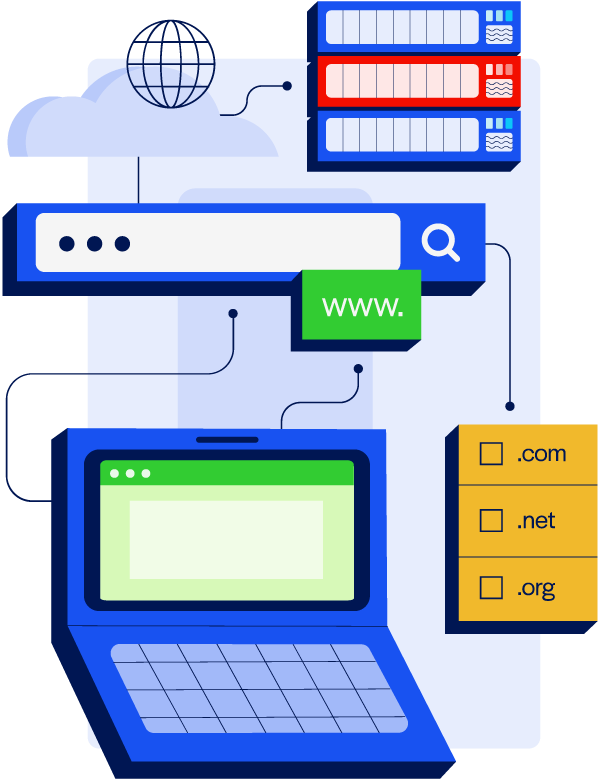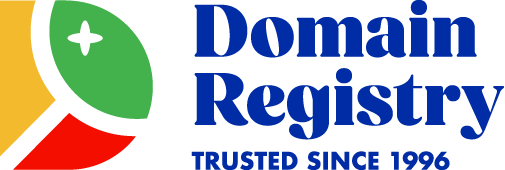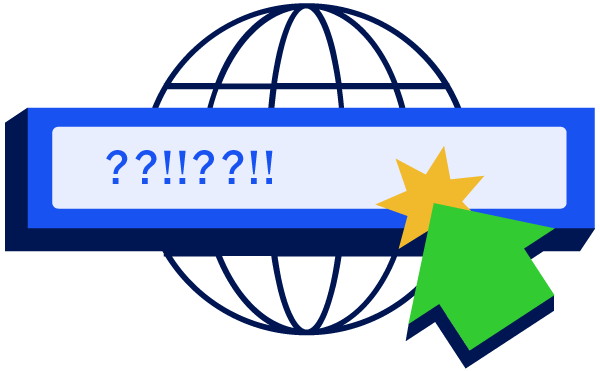Temporarily under construction. Please call our support staff if you have any questions or need assistance immediately.
What is Domain Registry?
A domain registry is an organization responsible for managing the top-level domain (TLD), such as .com, .net, .org, and more, for any given domain name. Domain registries can act as a database of available domains and work with registrars, such as DomainRegistry.com, to purchase a domain.
DomainRegistry.com can help you search, register, and manage your domain. As one of the oldest domain registrars out there – since 1996, in fact – we’ve been providing trusted domain registration and web hosting services to our clients for almost 30 years.
Looking for a new domain name for your business? You’ve come to right place! Start off by searching our site for your desired domain name. Our site will scan the Domain Name System (DNS database) to search for availability and then we’ll handle the purchase, registration, management, and renewal of your domain.

Why Do I Need a Domain Name?
Having a memorable and fitting domain name is essential for any business or personal brand. Here are some reasons why.
Creating a Strong
Online Identity
A domain name that aligns with your company name can help establish a consistent brand identity, making it easier for visitors to recognize and remember you.
Establishing
Credibility
A domain name that is closely related to your business or brand name can help establish credibility and legitimacy, building trust with visitors and encouraging them to take action.
Differentiating Your
Brand
A unique and catchy domain name can help you stand out from your competitors in a crowded online landscape.
Gaining
Authority
An older domain has more authority and can improve your website's search engine ranking, making it more likely to appear in the search engine results pages (SERPs).
Securing Your Online
Presence
Owning a domain name means that no one else can claim it and put up a website that could damage your brand. It gives you total control over your website's address and what potential clients see when they look for your business online.
How Do Domains Work?
Want to learn more about how domains work before you choose your own? Here’s a quick primer.

The Domain Name System (DNS)
The Domain Name System (DNS) is often referred to as the phonebook of the internet—but a more apt comparison might be your smartphone’s contacts list. Just as you use your stored contacts to quickly make calls—instead of entering a phone number—the DNS allows us to access websites by typing in easy-to-remember domain names, rather than long strings of numbers and decimals. It does this by mapping each domain name (like clairesboots.com) to its corresponding IP address (like 192.168.0.1).
Parts of a Domain Name
A domain, such as clairesboots.com, is made up of two parts: the second-level domain (SLD) and the top-level domain (TLD).
The second-level domain, “clairesboots” in this case, is the unique identifier for the website—and the top-level domain, “.com”, is the extension. Choosing an SLD that matches the business name or purpose will make it easier for users to find (and remember) your website.
Top-level domains indicate the type of entity, such as “.com” for commercial businesses, and “.edu” for educational institutions. The most popular TLD is “.com”, with over 158.6 million registered names.

The Domain Name System (DNS) is often referred to as the phonebook of the internet—but a more apt comparison might be your smartphone’s contacts list. Just as you use your stored contacts to quickly make calls—instead of entering a phone number—the DNS allows us to access websites by typing in easy-to-remember domain names, rather than long strings of numbers and decimals. It does this by mapping each domain name (like clairesboots.com) to its corresponding IP address (like 192.168.0.1).
Types of Top-Level Domains
Different types of top-level domains serve different purposes—and some come with unique requirements. Let’s take a closer look.
-
Generic Top-Level Domains (gTLDs)
These are the most common types of TLDs and include extensions like .com, .net, and .org. Generic TLDs can be registered by anyone, and are not restricted to specific organizations or industries.
-
Country Code Top-Level Domains (ccTLDs)
These are specific to a country or geographic region, and end in country code extensions—such as .ca for Canada or .au for Australia.
-
Sponsored Top Level Domain (sTLDs)
Sponsored Top Level Domains (sTLDs) like .edu and .gov, are sponsored by specific organizations or communities and are typically only available for registration to eligible organizations.
How to Get a Domain
Securing a domain name is the first step in establishing an online presence. Before we dive into the steps involved, it’s important to understand the following terms:
Domain Registry
A domain registry is an organization responsible for managing the top-level domain (TLD) for a given domain name, such as .com, .net, and .org.
Registrar
A registrar is a company that acts as an intermediary between customers and the domain registry, allowing customers to register, renew, and manage their domain names.
-
Choose a trusted registrar.
Selecting a reputable, reliable registrar is crucial—as they’ll handle the registration, management and renewal of your domain name. We have been an ICANN accredited registrar since 1996, providing trusted domain registration and web hosting services to our clients.
-
Check availability.
To check if a domain name is available, you can use a domain registrar’s website, such as ours. We have direct access to the DNS database and can provide accurate information on availability. Our search feature allows you to easily check the availability of multiple domain names—and when you find one that’s available, we can help you secure it.
-
Register the domain.
After finding an available domain name, the registration process is similar to any other online service. You will be asked to provide your contact information, select a payment method, and complete the registration. Most registrars, including ourselves, handle the technical work required to secure the domain name for you, and have it registered in less than a minute.

Alternative Options
While registering a domain through a trusted registrar is the most common (and straightforward) option, there are other ways to acquire a domain name.
These include buying through an auction, brokerage site, or even directly from an individual who already owns the domain. Keep in mind that these options may have higher prices and require additional steps to transfer ownership. But as a registrar, we can help with the transfer process.
Want to get in touch with the current owner of a domain? You can use a WHOIS search tool to find their updated contact information.
How Much do Domains Cost?
The cost of domain registration can vary depending on the top-level domain (TLD) and the popularity of the second-level domain.
For example, a domain with a TLD of .com and a high-demand second-level domain like “boots” could cost more than a less-popular second-level domain like clairesboots.net.

While registering a domain through a trusted registrar is the most common (and straightforward) option, there are other ways to acquire a domain name.
These include buying through an auction, brokerage site, or even directly from an individual who already owns the domain. Keep in mind that these options may have higher prices and require additional steps to transfer ownership. But as a registrar, we can help with the transfer process.
Want to get in touch with the current owner of a domain? You can use a WHOIS search tool to find their updated contact information.
Domain FAQs
In simple terms, a domain is the name of a website, like domainregistry.com. It’s the short, memorable handle—typically made up of 2 or 3 words—that sets your site apart from millions of others. Think of your website as a house, and your domain name as its unique street address.
But a domain name is just one part of a website’s full address, or URL. For example, in the URL https://www.clairesboots.com, the domain name is clairesboots.com. If you’re new to domains and not sure how it all works, don’t worry—we’ll get into the nitty-gritty details in this guide.
For now, let’s just state this obvious fact: your domain name is an essential part of your online presence. And if your business or brand doesn’t have an online presence yet? Well, it probably should.
Yes, you can buy—or register—a domain. But it isn’t a one-and-done transaction. You’ll need to renew your registration once a year to ensure the domain continues to belong to you.
There are a few things to keep in mind when choosing a domain name. It can only contain letters, numbers, and hyphens. You can’t use offensive or trademarked terms—and your domain name must be unique—it can’t be in use already.
When choosing a domain name, think about making it easy to remember, spell, and say. The shorter and more straightforward, the better. The closer to your brand name, the better.
Also, try to include keywords that are related to your business or industry. And, of course, make sure the domain name is available and can still be claimed.
It’s possible to trademark a domain name if it’s used in connection with goods or services and it’s unique, meaning it doesn’t look similar to other trademarks. However, it can be tricky, so we recommend you speak with a legal professional before doing so.
A domain name is like a street address—it’s where people go to find your website. Your website is like the house itself—it’s the salmon-pink 2-bedroom located at that address.
Your registrar should provide you with a free privacy protection service. This service will hide your personal contact information, such as name, address, and phone number, from public view. Instead, the registrar will list their contact information on the public domain registration records. In this way, your home address is protected from spam, fraud, or unwanted contact.

